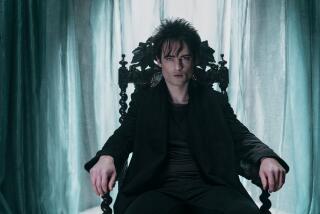Even for Neil Gaiman, ‘The Sandman’ is a singular dream
Even in casual conversation, British author Neil Gaiman sometimes sounds as if he’s narrating some dark fairy tale -- his sentences slither across old stone floors or flit on gossamer wings. He also happens to live in a rambling Minnesota manse that looks, Gaiman says, as if it were “drawn by Charles Addams on a day he was feeling particularly morbid.”
So it’s no surprise that fans of the fantasy novelist have whispered for years that Gaiman bears more than a passing resemblance to his signature creation, the Sandman, the spooky comic-book character that debuted 20 years ago and brought a new literary ambition to the pop medium.
“He’s a lot like me, only with an immortal’s superpowers and no sense of humor of any kind,” Gaiman said. “Hmm. So in fact, he isn’t anything like me at all, but he does have very messy hair. That was a great point of correspondence between me and the character. He’s much paler than I am too.”
Gaiman came up in the comic-book world, but his prowess as a storyteller took him far beyond its bordered pages. His bestselling novels “American Gods” and “Anansi Boys” helped establish his credentials with the critics, and the sly 1999 fantasy “Stardust” was adapted to the screen in 2007. His other Hollywood pursuits have included the Robert Zemeckis computer-animated epic “Beowulf” (Gaiman co-wrote the script) and the February release “Coraline,” which director Henry Selick (“Tim Burton’s The Nightmare Before Christmas”) is adapting from Gaiman’s novel for young adults.
But despite that career climb, it is the character of Sandman that follows most closely at the feet of the 48-year-old Gaiman like some staircase shadow. Far from a superhero, Sandman was a supernatural lord of dreams, going by several names, including Dream and Morpheus. In 75 monthly issues that spanned seven years, the spectral being brought readers into often nightmarish worlds like some cross between Rod Serling and one of the Christmas spooks from Dickens.
Gaiman said that he came to the premise with a sort of “1,001 Arabian Nights” motivation.
“It was an idea of trying to take something very literally: What would it be like to live in dreams? A lot of that came out of terror. I was a young writer and had never written anything monthly. I needed a story shape that could take me anywhere, because my fear was: What if I run out of stories? So I thought, ‘I will have somebody who has existed since the dawn of time, so that gives me the entirety of human history to play with for stories.’ ”
One issue would delve into the dreams of William Shakespeare, another, inspired by T.S. Eliot, would wander through the night visions of cats. There were mystic battles and supernatural showdowns too, but this was clearly a comic book that challenged the genre stereotypes that were still in full force at that time. Along with the work of Alan Moore, Frank Miller and Art Spiegelman, Gaiman’s twilight saga was a watershed moment proving the growing sophistication of comics.
“If you were a betting man, up until that point in ongoing comics, critical success was completely synonymous with commercial failure,” Gaiman said. “The two were so utterly hand-in-hand. With ‘Sandman,’ we were getting the critical success, but we weren’t getting the commercial failure. At issue No. 8 we were selling more than anything comparable had sold for 25 years before that.”
Stephen King, Tori Amos and the late Norman Mailer were just some of the vocal devotees of the comics, which have been republished now as trade paperback collections and even lavish hardcover editions that reach more readers today than ever before.
One of the more fascinating aspects of the Sandman comics was the supporting cast, which included Dream’s siblings, magical incarnations with one-word names who were collectively called the Endless; among them were his beautiful sister Death (who looks like a Depeche Mode fan), his somber brother Destiny, his wild-eyed sister Delirium, the toadish Despair and so on. Their motivations and machinations became fascinating to watch, a chess game played by deities, or a mash-up between “The Sopranos” and a Tarot deck.
“Most characters in comics simply didn’t have any families, and it was something I loved. It was something I loved to write about. When I first came out to America, people told me that in ‘The Sandman’ I created a dysfunctional family, which was not a phrase I had heard before that in England,” Gaiman said. “I talked to people about it, and I realized that what people in America called ‘a dysfunctional family’ was the same thing that we in England referred to as ‘a family.’ You didn’t see a lot of functional ones.”
Gaiman said it’s hard for him to wrap his arms around the entire Sandman epic, a story he doubts he would ever have started if he had known its final breadth -- 2,000 pages and a quarter of a million words.
“I was like somebody who decided to hitchhike from Los Angeles to San Francisco -- you know the shape of the journey but you don’t know which little towns you are going to get stuck in or where something is going to break down or where you’re going to be riding on some elderly fruit truck that can’t make it over 40 miles per hour. You know the shape, but you don’t know the nature of the journey. And then there’s always the weather. . . .”
With the comic-book and fantasy films of today, especially the work of directors such as Peter Jackson or Guillermo del Toro, the logical question as Sandman celebrates its 20th year in pop culture is whether a movie adaptation will be hitting theaters before the silver anniversary arrives. Gaiman said it’s inevitable a film will be made.
“My feeling today is that I would so much rather there be no movie than there be a bad movie,” Gaiman said. “We’re getting closer and closer to the point where you could make a Sandman movie, just because the world is changing. The thing that has really made it practical for the superhero movies to exist is the simple fact that you can put it on screen now. With trying to make superhero movies over the years, it has always been that you simply couldn’t do it. They would say, ‘You will believe a man can fly,’ but you really wouldn’t. Now, you pretty much can.”
Still, Gaiman was badly bruised by the experience of “Stardust,” a film that did not do well in America, which the author blames on a wrongheaded studio marketing plan (“They had something,” he said, “like ‘Princess Bride’ and they promoted it like it was ‘Ella Enchanted’ ”). He’s fretting now about “Coraline,” a 3-D, stop-motion adaptation, although he gushes about the talents of director Selick.
For Sandman, meanwhile, Gaiman will daydream about the ideal filmmaker arriving to awaken the property’s silver-screen potential.
“The only thing I hope for is that whoever it goes to has the same amount of passion for it that Peter Jackson brought to ‘Lord of the Rings.’ I want someone who will make the film because he loved it and he cared about it and if anybody was going to screw it up, it was going to be him. . . . There is someone out there. Or there will be someone out there in five or 10 years.”
More to Read
The biggest entertainment stories
Get our big stories about Hollywood, film, television, music, arts, culture and more right in your inbox as soon as they publish.
You may occasionally receive promotional content from the Los Angeles Times.










